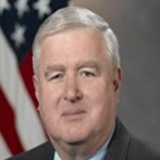Pummill Interview

Danny Pummill
Acting Under Secretary for Benefits
U.S. Department of Veterans Affairs
What are some of the current challenges facing the VA, and what is being done to address them?
At the Veterans Benefits Administration (VBA), the biggest challenge we are currently facing is our disability claim appeals system. The current VA appeals process is broken and leaving Veterans feeling justifiably frustrated. The time to modernize the appeals process is now. We are taking action to transform it into the timely, fair appeals process our Veterans deserve. With the help of Congress and thanks to hard work of Veterans Service Organizations (VSOs), State Directors of Veterans Affairs and other Veteran advocates, Veterans will be looking forward to a simplified, streamlined, and fair appeals process. In five years, Veterans could have 90 percent of their appeals resolved within one year of filing.
Across the Department, we are also asking Congress for modest flexibility to overcome artificial funding restrictions to make us more responsive to Veterans’ emerging needs.
How has the VA improved efficiency to accommodate the growing population of veterans?
At VBA, we have made huge strides in improving efficiency since 2011 by transforming from a paper-based to a digital processing system. We now process 99.8% of disability compensation claims electronically. A technological cornerstone of this transformation is the Veterans Benefits Management System (VBMS), an electronic claims processing solution designed to improve benefits delivery to Veterans, their families and Survivors. The increased speed and efficiency of processing claims in VBMS enabled us to reduce the disability claims backlog by 88% from its peak of 611,000 claims in March 2013 to 76,000 claims as of Monday, May 16. We also reduced the average days pending for each claim from a peak of 282 days to 89 days as of May 16. Through VBMS, VBA employees have completed more than four and a half million rating decisions and nearly three million claims from end-to-end.
While increasing speed and efficiency, we also improved quality. We measure quality in three different ways: claim-based quality, issue-based quality, and on each error category inside of a claim. Claims-based quality increased 8 percentage points from 83% to 90% today. Issue-based quality is 96%. And in seven of the eight error categories where we measure quality, it is 98% (the seventh is 97%).
Can you explain the different responsibilities of the VHA vs VBA and what the key priorities of both are in the next few years?
VBA administers VA’s non-medical benefit programs for Veterans, Service members, their families and survivors. These include disability compensation, pension and fiduciary, education, home loan guaranty, life insurance, vocational rehabilitation and employment, and transition, employment and economic impact. VBA expects to distribute an estimated nearly $100 billion in benefits in FY2016.
VHA, of course, runs VA’s health care system. This includes primary and specialty care, long-term care, rehabilitative care, health promotion, mental health services, prosthetics services, and medical research.
I would be remiss if I didn’t also mention VA’s third administration, the National Cemetery Administration (NCA), which manages memorials and burials, headstones and markers, national shrines and state grants for our deceased Veterans and their families.
The key priority of VA as a Department – all three administrations – is to improve the Veteran experience. That is the ultimate goal of the Secretary’s MyVA initiative. We have five major objectives toward that end. First, as I already mentioned, improve Veterans’ experience—a seamless, integrated, responsive customer-service experience, every time. Second, improve employees’ experience by eliminating barriers to excellent customer service. Third, improve internal support services. Fourth, grow a culture of continuous improvement to identify and correct problems faster and replicate solutions nationwide. Fifth, strengthen strategic partnerships by building vital and innovative networks of collaborative relationships across federal, state, and local governments, and with both non-profit and for-profit organizations. These are the common goals of the entire Department – VBA, VHA and NCA.
What do you hope that your audience gains from your speaking session?
I hope the audience took away many of the things I already mentioned, specifically how far VBA has come through our transformation from 2011 to 2015 and our way ahead for the future.
In just five short years, VBA has come a long way by transforming from a paper-based to a digital system. We now process most all of our disability compensation claims electronically. We have driven down the backlog of disability compensation claims by 88%. We raised issue-based quality to 96%. And currently, the average days a claim is pending is 89 days and it takes an average of 124 days for us to complete a claim.
Looking forward, we’re focused on the Secretary’s MyVA 12 Breakthrough Priorities and pushing forward on those among them that are directly in VBA’s area. That means we’re seriously looking at and testing ways to improve the Compensation and Pension exam experience for our Veterans. We’re modernizing our call centers and increasing the amount of claims processing we can do over the phone. We’re coming up with a way to simplify the appeals process, with help from our partners. We’re working to improve dependency claims processing, an FY16-17 Agency Priority Goal. We’re also implementing National Work Queue to balance our benefits delivery to Veterans nationwide.
How did you enjoy the event?
Due to scheduling constraints I was only able to attend for my speaking session, but my impression was of a well-rounded event with a lot of great minds coming together to discuss VA health care challenges and solutions.



